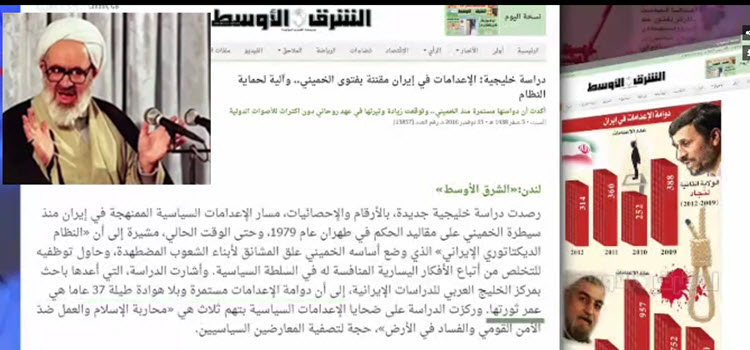
Alsharq Al-Awsat Newspaper published a report on 5th November 2016 about the results of research that was carried out by the Khalij-e-Fars (Persian Gulf) researchers regarding the 1988 massacre in which political prisoners in Iran were systematically executed.
The newspaper article said that the researchers looked into the statistics, numbers and the events related to the numerous executions in Iran in 1988 when Khomeini was in office.Iran’s dictatorial regime is established on the gallows that Khomeini founded. It uses suppression and execution as a way of eliminating rivals who think differently and have differing ideologies. The executions have still continued since the 1988 massacre.
The research looked at the three charges of “waging war against Islam”, “acting against the national security” and “rooting corruption in the society”. These three charges were the excuse the Mullahs’ regime used for eliminating the political dissidents.
The researchers wrote about the massacre of political prisoners and also the consequences of the audio recording that was released by Ayatollah Montazeri. Khomeini ordered a Fatwa to allow the execution of the PMOI (MEK) and those who were against the regime in 1988. As a result, the Judiciary of Iran allowed the sentence to go through and executed approximately 30,000 people.
The 40-minute audio recording was released on the official website of the former successor of Khomeini, Ayatollah Hossein Ali Montazeri in August 2016. In the recorded conversation we hear Ayatollah Montazeri speaking to the 4 members of Khomeini’s “death committee”.
Many of the political prisoners who were executed were previously sentenced to imprisonment or were serving their time in prison. Some other people who were executed had been previously released from prison, but imprisoned again on Khomeini’s order. They were executed because they had family connections with the members and supporters of the PMOI (MEK).
The tape is proof that former and current leaders of the Iranian regime played a significant role in the 1988 massacre. The current Supreme Leader, Khamenei, was the president during those years and was therefore one of the main perpetrators of the atrocity.
Ali Akbar Hashemi Rafsanjani was the head of Parliament at that time and is now the chairman of the Expediency Discernment Council. He was in close contact with Khomeini for important decisions related to the execution of political prisoners.
The report refers to future prospects and consequences. If Hassan Rouhani takes office for a second time it is unlikely that the number of executions carried out in Iran will decrease. The Iranian regime sees political opponents as a direct threat to its own survival and continuity, therefore resorts to executions to control its fear.







